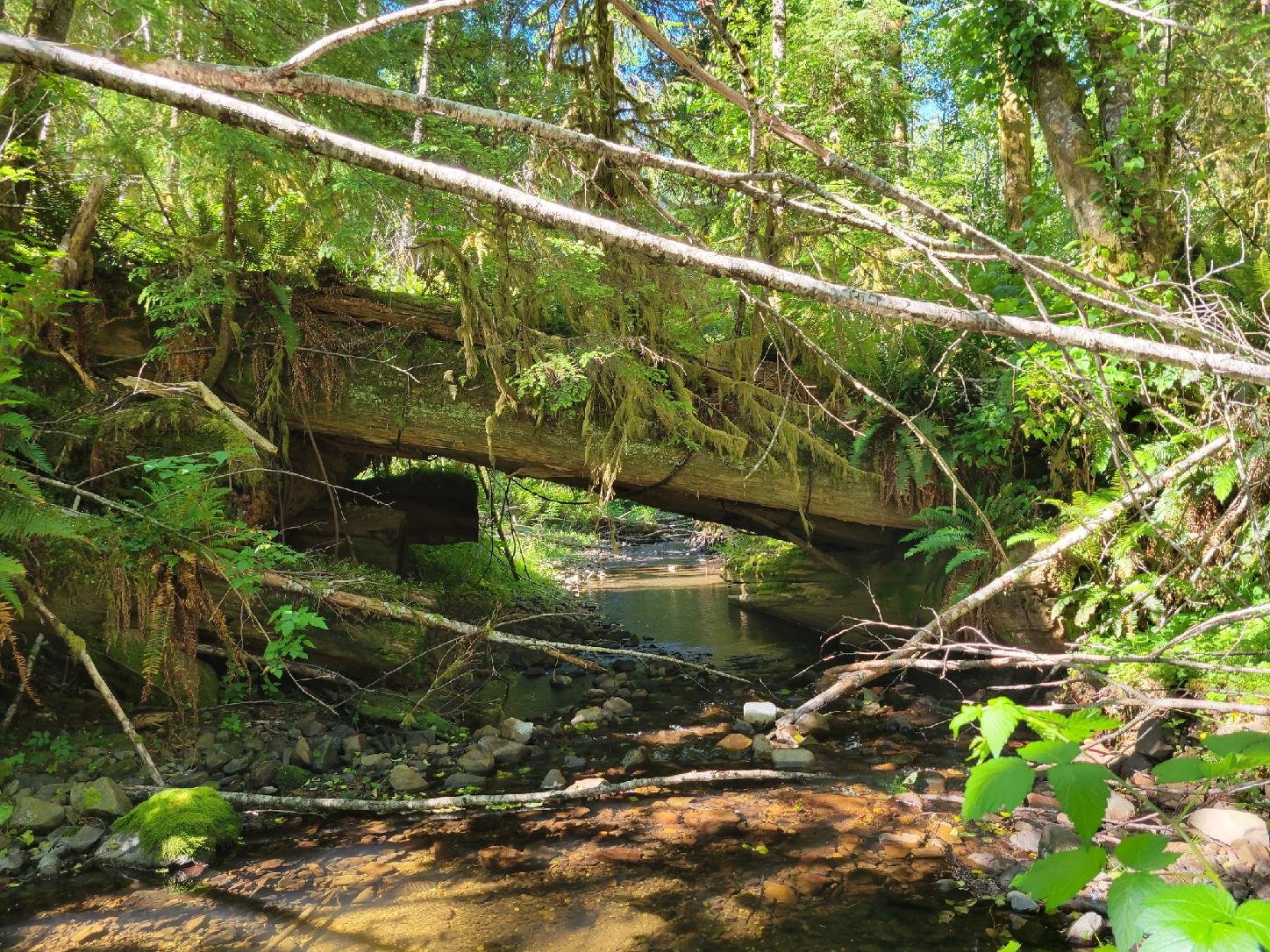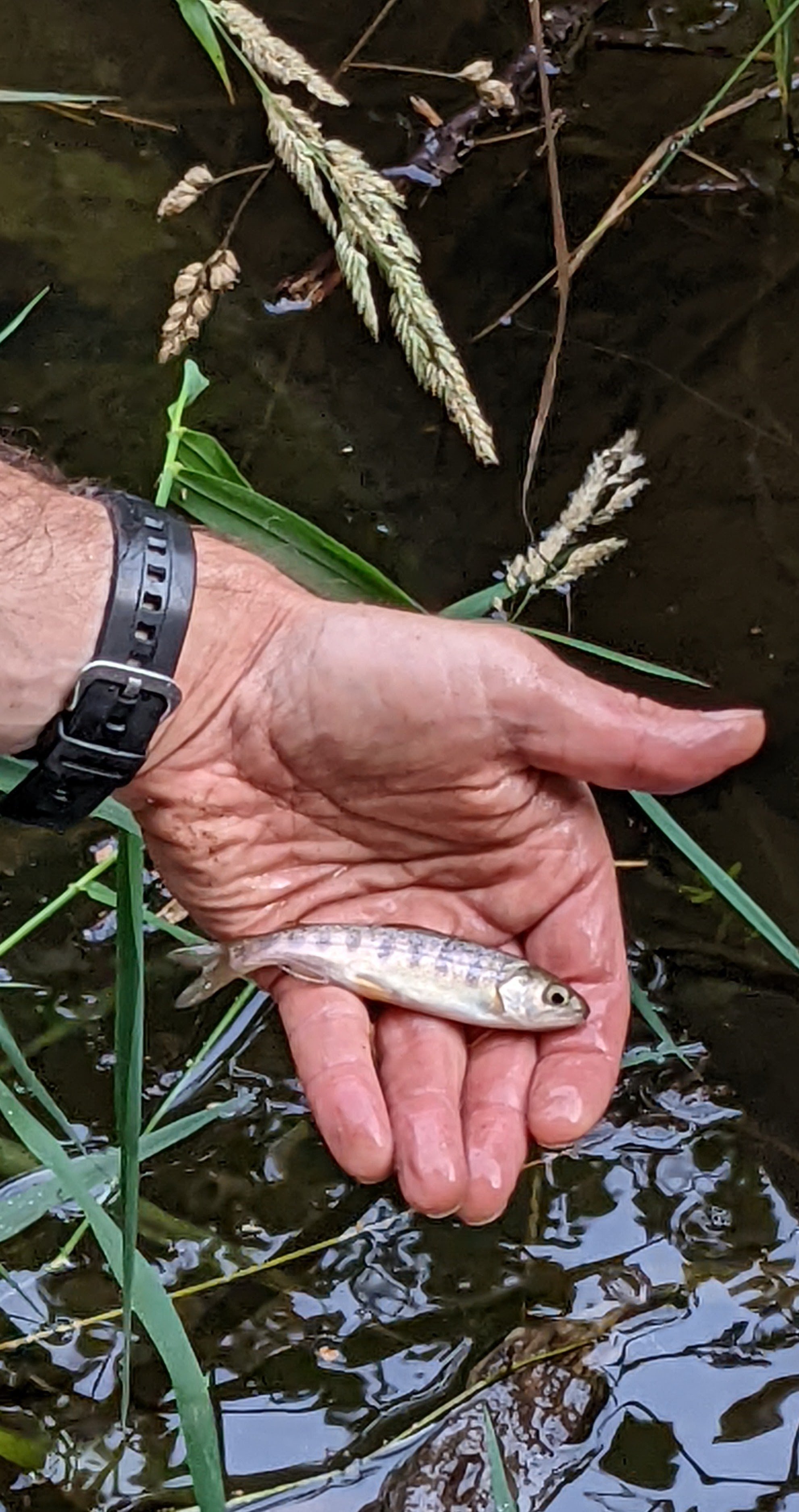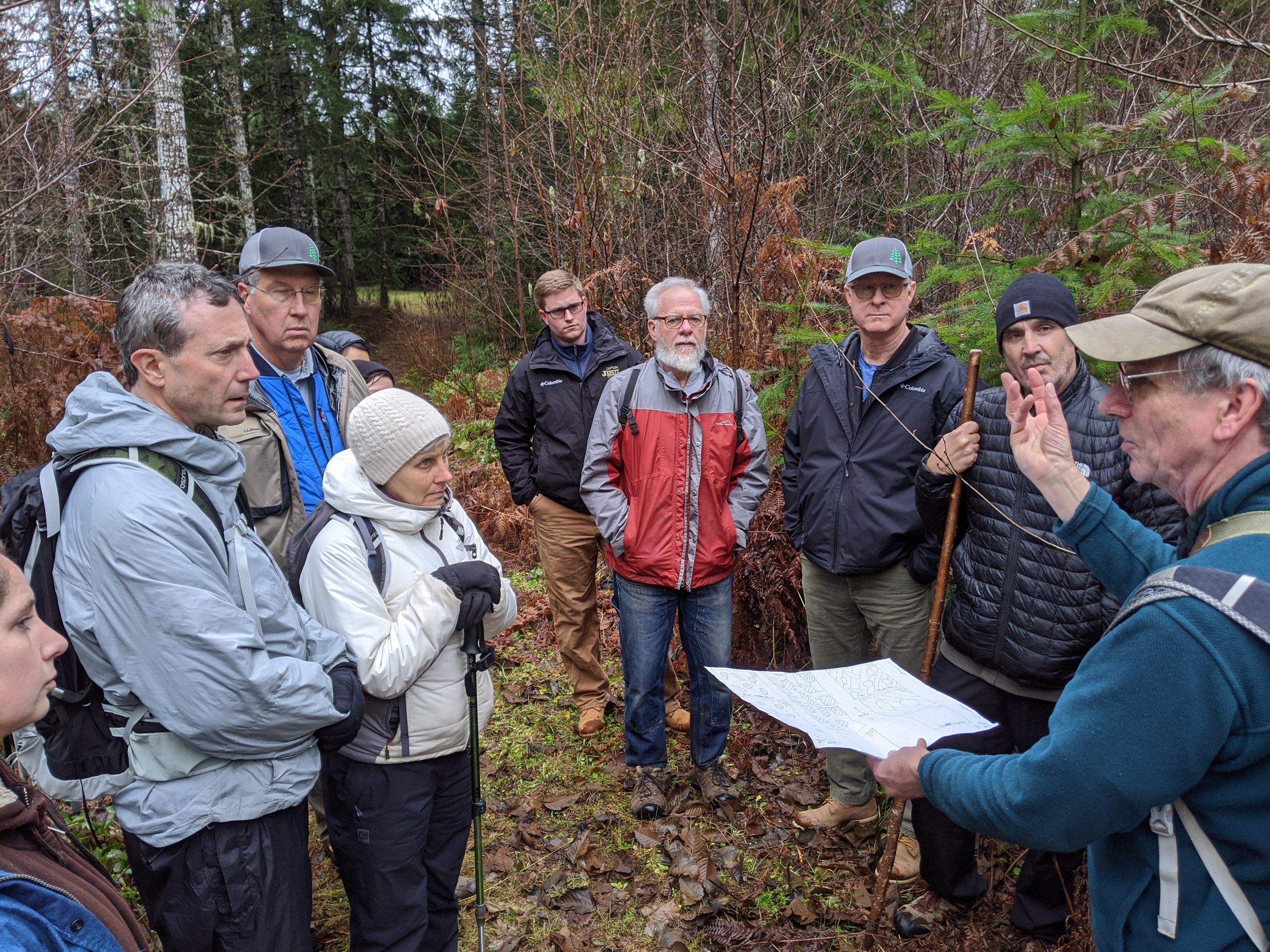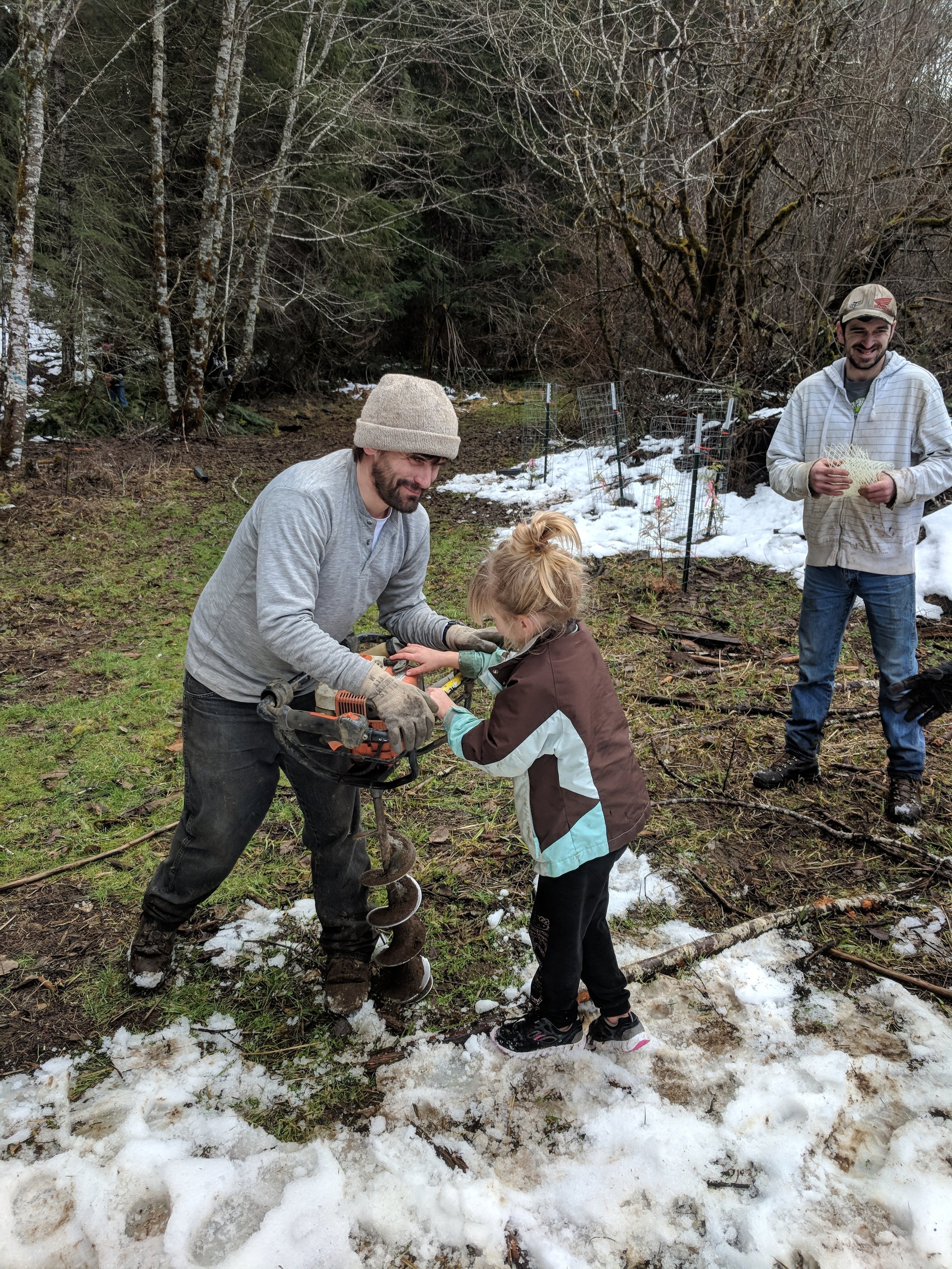
Projects
Project Types
We prioritize our work through a series of Strategic Action Plans and other assessments that use the best data available to identify where the highest benefit to Salmon Populations can be achieved.
Our three primary project types that we implement with willing landowners are:
Riparian Enhancement (Planting Projects)
Fish Passage
In Stream Enhancement
-
A Riparian area is the area along the edge of a body of water (stream, river, pond, bog, marsh etc) that is influenced by that water body. Riparian areas can be identified by the presence of wetland plants that are able to grow there thanks to the presence of that water body. Functioning riparian habitats have healthy vegetation populations of native tree, shrub, and herbaceous plant, are regularly flooded in the rainy season, and shift as the edges of a water body shift such as when a stream naturally migrates. Our work focuses mostly on stream and river adjacent riparian areas.
Why (re)plant along streams?
Healthy riparian areas serve very important functions for Salmon and other fish species. They shade streams and rivers, keeping the water cool. When they flood they slow water flow, mitigating downstream flooding and allowing for groundwater recharge. A riparian area’s vegetation and leaf litter support populations of aquatic insects that are important food sources for juvenile Salmon. Finally, the trees that grow in a healthy riparian area eventually fall into the stream or river, whether due to age or bank erosion. The fallen trees provide important in-stream habitat diversity and more.
In the Nehalem Watershed, development has impacted riparian areas to the detriment of humans, fish, and wildlife. The removal of trees and shrubs from those areas causes warming of streams and rivers by the sun, negatively impacting juvenile Salmon growth and development. Additionally, removing these trees and shrubs reduces leaf litter in the streams which reduces forage for the aquatic insects juvenile Salmon eat. Invasive plant species like Himalayan blackberries and Japanese knotweed also move into these areas, dominating them and preventing native trees and shrubs from reestablishing. The thin and shallow root systems of these invasive plants also makes stream banks more susceptible to erosion. Without native trees and shrubs growing the benefits of a healthy riparian area are lost.
How do we (re)plant riparian areas?
We regularly partner with landowners to explore replanting of existing riparian zones on their property. If you’re a landowner interested in a property visit, please contact us. With support from grant funds and in partnership with the Back Yard Planting Program (BYPP) our goal is to replant riparian areas with native trees and shrubs and restore riparian areas into a balanced state. We look forward to working with you!
-
There are many types of barriers to fish passage that can be found in the Nehalem Watershed. These include natural barriers like tall waterfalls or large debris flows. They also include human made fish passage barriers like dams, tide gates, and culverts.
Why replace barriers?
Fish passage barriers prevent migration of salmon, limit salmon reproduction and rearing, and ultimately overall salmon population in the watershed. A dam, seasonal or permanent, prevents the migration of juvenile or adult salmon seeking spawning habitat, cool water, shelter from predation, or new areas to forage. Culverts may prevent migration by being too small, limiting migration for adult or juvenile salmon due to water velocity. Culverts can be perched above the stream, blocking migration like a waterfall or dam. Tide gates can prevent salmon access to estuary habitat which is a critically limited habitat for juvenile salmon.
How do I replace a barrier?
When invited by a landowner, we will first check to see if the potential barrier is on a stream listed as being used by salmon or lamprey. We had an assessment conducted in 2016 of nearly all the culverts accessible to salmon in our coverage area. Additionally, nearly all of the tide gates in the estuary were assessed in 2021.
Once a stream has been confirmed to have salmon or lamprey present, we will visit the site to conduct an initial assessment of the barrier. Grant funding is available for complete or partial costs of replacement or removal of existing barriers. The goal of our assessment is to establish whether the structure is appropriate for grant funding.
We will then prepare and submit the application, hire an appropriate engineer for the project, develop designs for either removal of the barrier or replacement with a fish-passable structure, and hire a contractor to implement the designs.
Next Steps
If you have a potential fish barrier on your property and you would like assistance in its removal or replacement, please contact us.
-
In-Stream Enhancements refer to a variety of actions that enhance habitat in a stream channel. These include strategic placements of in-stream wood like log jams, beaver dam analogues, roughened channels, and a variety of other actions. The goals of these actions is to restore natural functions that have been impaired through removal of in-stream wood from waterways.
Why add wood to streams?
In-stream wood serves many important functions. A critical function is providing habitat diversity: as the wood redirects stream flow it carves out pools, sorts gravels, and can sometimes create new side channels or alcoves. This diversity is important because fish and their prey use different habitats for different functions like avoiding predators, foraging for food, or just to avoid high velocity flows. In-stream wood does more than this, though. It also slows down stream flow, reducing overall erosion and stream bed scour. By slowing down the flow of the water, in-stream wood also helps the stream bed to accumulate sediment and encourages localized flooding. This flood plain interaction contributes to nutrient cycling between the stream and riparian areas and also creates new side channels and alcoves for fish to use to escape high flow events.
Sometimes a stream, because of its lack of wood, will have very high stream banks, making flood plain interactions difficult to achieve even with in-stream wood. In these cases other interventions may be needed to restore those natural functions. These can include beaver dam analogues, sediment supplementation, or a variety of other techniques. These are applied in specific scenarios.
How is wood added?
Downstream infrastructure, flood potential, and more all need to be carefully considered before implementing in-stream enhancements. While they can be complex undertakings, in-stream enhancements have wide-ranging and impactful ecological benefits. Our project at West Fork Coal Creek is a great example of a successful collaboration between landowners and NBWC. It documents the experiences of several landowners going through a large wood placement on their properties.
Next Steps
We encourage landowners interested in exploring in-stream enhancements to contact us.
PARTNER PROJECT FORM
Interested in working with us? Fill out the form below and we will be in touch with you shortly.
OUR WORK PLAN
Click on the buttons below to view our MOU and Strategic Action Plan. We are currently developing our ten year plan for the Nehalem Basin.
Our Projects





















































































































